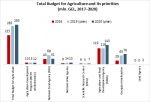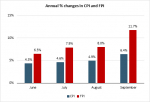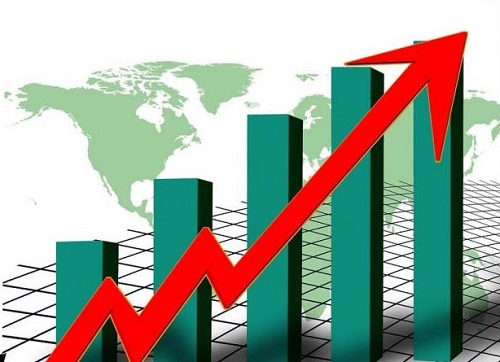In the middle of September, food prices increased by 12% y/y (that is, compared to September 2016).
On an annual basis, the biggest price increases occurred for apples (87%), potatoes (46%) and carrots (42%), whereas cucumbers, peaches and tomatoes, on the contrary, became cheaper by 25%, 20%, and 14%, respectively.
The majority of food products in the bundle became more expensive compared to the same period of the previous year, leading to an overall increase of 12% in the food prices offered by the largest supermarkets of Tbilisi. This finding is in line with Geostat’s data, which confirms an increasing trend in food prices and shows that the major drivers of the increase are fruits, vegetables, and dairy products.
 Since seasonality is not contributing to the yearly changes, one has to look for other reasons to explain such a large increase in food prices. Given the increasing number of tourists willing to explore Georgia, increased demand from tourists may be a possible explanation for higher food prices. According to the latest data from the Georgian National Tourism Administration (GNTA), in August of 2017, the number of international arrivals in Georgia amounted to 1,080,449, representing a 27.4% increase over the same period in 2016. Out of the total number of visits, 573,368 lasted longer than 24 hours, which corresponds to the annual increase of 27.2%.
Since seasonality is not contributing to the yearly changes, one has to look for other reasons to explain such a large increase in food prices. Given the increasing number of tourists willing to explore Georgia, increased demand from tourists may be a possible explanation for higher food prices. According to the latest data from the Georgian National Tourism Administration (GNTA), in August of 2017, the number of international arrivals in Georgia amounted to 1,080,449, representing a 27.4% increase over the same period in 2016. Out of the total number of visits, 573,368 lasted longer than 24 hours, which corresponds to the annual increase of 27.2%.
Prices might stabilize by the end of September, as vacations are over and everybody gets back to work and school.
Food Price Index Recent Publications
-
JUNE 2021 | AGRI REVIEW
 On 15 June 2021, the National Statistics Office of Georgia published its annual publication for the agricultural sector - Agriculture of Georgia 2020. According to the publication, agriculture, forestry, and fishing comprised 8.4% of GDP in 2020, higher than the 7.2% share in 2019, but in line with the general trend over the last five years (agricultural GDP comprising on average 7-8% of GDP). Agricultural GDP in nominal terms increased by 13% on an annual basis.… Read More
On 15 June 2021, the National Statistics Office of Georgia published its annual publication for the agricultural sector - Agriculture of Georgia 2020. According to the publication, agriculture, forestry, and fishing comprised 8.4% of GDP in 2020, higher than the 7.2% share in 2019, but in line with the general trend over the last five years (agricultural GDP comprising on average 7-8% of GDP). Agricultural GDP in nominal terms increased by 13% on an annual basis.… Read More
-
MARCH 2021 | AGRI REVIEW
 On 29 December 2020, the parliament of Georgia approved the state budget for 2021, which includes allocations of around 18.3 billion GEL. From which the Ministry of Environmental Protection and Agriculture (MEPA) will receive 451.6 million (2.5% of the total budget allocation). MEPA will direct 10 mln. GEL towards the Environmental Protection and Agriculture Development Program (2.2% of MEPA’s total budget), with around 389.6 mln. (86.3% of MEPA’s total budget) to be allocated to agricultural… Read More
On 29 December 2020, the parliament of Georgia approved the state budget for 2021, which includes allocations of around 18.3 billion GEL. From which the Ministry of Environmental Protection and Agriculture (MEPA) will receive 451.6 million (2.5% of the total budget allocation). MEPA will direct 10 mln. GEL towards the Environmental Protection and Agriculture Development Program (2.2% of MEPA’s total budget), with around 389.6 mln. (86.3% of MEPA’s total budget) to be allocated to agricultural… Read More
-
DECEMBER 2020 | AGRI REVIEW
 The COVID-19 pandemic raised concerns about the food security of many countries, in particular import-dependent developing countries like Georgia. Trade restrictions imposed by Georgia’s trade partners tightened the supply of some cereals and vegetables, signalling the risk of an increase in food prices. While there is no formal evidence of food insecurity due to the pandemic, given that Georgia is a net importer of wheat the state subsidized wheat imports, and, according to Georgia’s Wheat… Read More
The COVID-19 pandemic raised concerns about the food security of many countries, in particular import-dependent developing countries like Georgia. Trade restrictions imposed by Georgia’s trade partners tightened the supply of some cereals and vegetables, signalling the risk of an increase in food prices. While there is no formal evidence of food insecurity due to the pandemic, given that Georgia is a net importer of wheat the state subsidized wheat imports, and, according to Georgia’s Wheat… Read More
-
OCTOBER 2020 | AGRI REVIEW
 The National Statistics Office of Georgia (GeoStat) recently published its economic review for Quarter II 2020. The publication highlights that agricultural production increased by 4.7% in the second quarter of the year compared to the same period in 2019. Furthermore, agriculture contributed to 10.2% of the country’s total GDP during the same period. In the second quarter of 2020, Foreign Direct Investments (FDI) in agriculture also increased and were almost six times higher than the… Read More
The National Statistics Office of Georgia (GeoStat) recently published its economic review for Quarter II 2020. The publication highlights that agricultural production increased by 4.7% in the second quarter of the year compared to the same period in 2019. Furthermore, agriculture contributed to 10.2% of the country’s total GDP during the same period. In the second quarter of 2020, Foreign Direct Investments (FDI) in agriculture also increased and were almost six times higher than the… Read More
-
JUNE 2020 | AGRI REVIEW
 On 15 June 2020, the National Statistics Office of Georgia published its annual publication for the agricultural sector - Agriculture of Georgia 2019. The publication shows that agriculture, forestry, and fishing comprised 7.2% of the nominal GDP in 2019, slightly lower than the 7.8% share in 2018, but in line with the general trend over the last five years (on average 7-8% of GDP). In nominal terms, the output of agriculture increased by 4% in 2019… Read More
On 15 June 2020, the National Statistics Office of Georgia published its annual publication for the agricultural sector - Agriculture of Georgia 2019. The publication shows that agriculture, forestry, and fishing comprised 7.2% of the nominal GDP in 2019, slightly lower than the 7.8% share in 2018, but in line with the general trend over the last five years (on average 7-8% of GDP). In nominal terms, the output of agriculture increased by 4% in 2019… Read More
-
DECEMBER 2019 | AGRI REVIEW
 On December 10, the parliament of Georgia approved the state budget for 2020. The budget includes allocations of around 14.4 billion GEL. Out of which, the Ministry of Environmental Protection and Agriculture (MEPA) will receive 353 mln. GEL (2.4% of the total budget allocation). MEPA will direct approximately 293 mln. GEL (2.0% of the total budget allocation) towards agricultural development and 60 mln. GEL (0.4%) will be spent on environmental protection. Compared to 2019, the… Read More
On December 10, the parliament of Georgia approved the state budget for 2020. The budget includes allocations of around 14.4 billion GEL. Out of which, the Ministry of Environmental Protection and Agriculture (MEPA) will receive 353 mln. GEL (2.4% of the total budget allocation). MEPA will direct approximately 293 mln. GEL (2.0% of the total budget allocation) towards agricultural development and 60 mln. GEL (0.4%) will be spent on environmental protection. Compared to 2019, the… Read More
-
OCTOBER 2019 | AGRI REVIEW
 On 30 August 2019, a public hearing to discuss Georgia’s Rural and Agricultural Development Strategy for 2021-2027 was conducted at the Ministry of Environmental Protection and Agriculture (MEPA). The new strategy document represents a roadmap for Georgia’s rural and agricultural development for the next decade. The strategy outlines three major goals to be achieved by 2027: 1. Increasing the competitiveness of agricultural and non-agricultural sectors; 2. Sustainable management of natural resources, preservation of ecosystems, and… Read More
On 30 August 2019, a public hearing to discuss Georgia’s Rural and Agricultural Development Strategy for 2021-2027 was conducted at the Ministry of Environmental Protection and Agriculture (MEPA). The new strategy document represents a roadmap for Georgia’s rural and agricultural development for the next decade. The strategy outlines three major goals to be achieved by 2027: 1. Increasing the competitiveness of agricultural and non-agricultural sectors; 2. Sustainable management of natural resources, preservation of ecosystems, and… Read More
- 1
- 2
- 3
- 4
- 5
- 6
- 7
- 8
- 9
- 10











